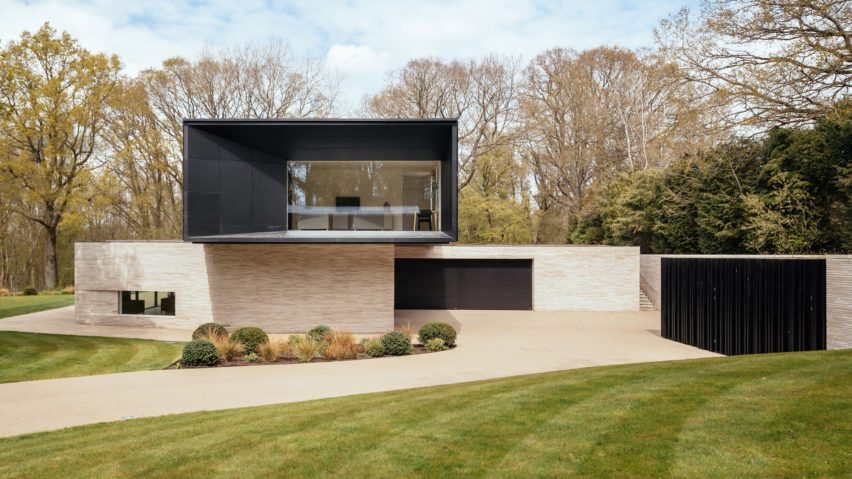British architecture studio Ayre Chamberlain Gaunt has completed a Hampshire house that aims to makes life easier for a wheelchair user, while not compromising on design quality.
Every room in Claywood is designed to be both accessible and functional for retiree Jo Wright, who became a wheelchair user after suffering a spinal cord injury.
Rather than creating a building that looks like a disabled person's home, Ayre Chamberlain Gaunt has produced a family home that embraces contemporary architecture.
The building has a sculptural form consisting of two volumes: a textural ground floor with pale walls of textured brick and a black timber-clad first floor that cantilevers over the ends of the block below.
"A key part of the brief was for us to design a house that didn't appear to be obviously designed for wheelchairs," studio co-founder Dominic Gaunt told Dezeen.
Claywood is home to Jo and husband David Wright, and also accommodates their three grown-up children.
The couple decided to build the house after realising their previous home couldn't be adapted to meet their needs – there would always be areas out of bounds to Jo – and failing to find an appropriate property for sale.
Instead, they sectioned off a portion of their former home's extensive grounds to create a new plot.
"Jo was adamant that she had to sleep upstairs on the same floor as her family," Gaunt told Dezeen.
"It had pained her to be unable to see her children's bedrooms for eight years, unable to go to them when they were unwell."
Organised over two storeys, the building's layout is loosely organised into three zones.
On the ground floor, living spaces are clustered together at the south end of the building, with a glazed wall that allows dining to extend outside.
The north end accommodates specialist facilities including a swimming pool and a therapy room.
The first floor is mainly for bedrooms; there are five in total, plus a small home office.
There's also a separate annex located at the site's entrance, which could be used by a carer in the future.
Throughout, the house carefully integrates a number of accessible features such as level thresholds, extra-wide corridors, lift access and specialist furniture.
Much of the architecture is planned to work for both seated and standing positions.
Glazing throughout the house includes floor-to-ceiling and low windows, while the cantilevered main bedroom is designed to give Jo an uninterrupted view of the landscape at times when she is bed-bound.
"The master bedroom almost touches the tree canopy of the woodland beyond and gives a feeling of suspension, particularly when the sliding doors are opened," said Gaunt.
The same approach extends to furnishings and fittings, which were designed with help from an accessibility consultant.
The oven and washing machine are elevated so Jo can reach them, worktops are set at two different heights, a clothes drying rack is attached to a pulley system, and the dining table was custom designed at a non-standard height.
"Whilst the house incorporates a lot of specialist items and automation, much of the design was simply about ensuring things are in the right places and set at appropriate heights," explained Gaunt.
To help the architects understand the level of details required, Jo lent Ayre Chamberlain Gaunt one of her wheelchairs in the early stages of the project, which helped them to understand some of her daily frustrations.
According to Gaunt, the experience proved so eye-opening that the firm plans to take a more accessible approach to other projects in future.
"It's been a really useful experience for us and we're far more conscious of inclusive design than we used to be across our all work, irrespective of typology," he said.
"It's now very much at the forefront of our work and informs early design decisions."
Other recent homes designed for accessibility include a House for Theo and Oskar in nearby Surrey, Gap Cove House in Massachusetts, USA, and Glass Trefoil House in Vermont, USA.
The photography is by Jim Stephenson.

